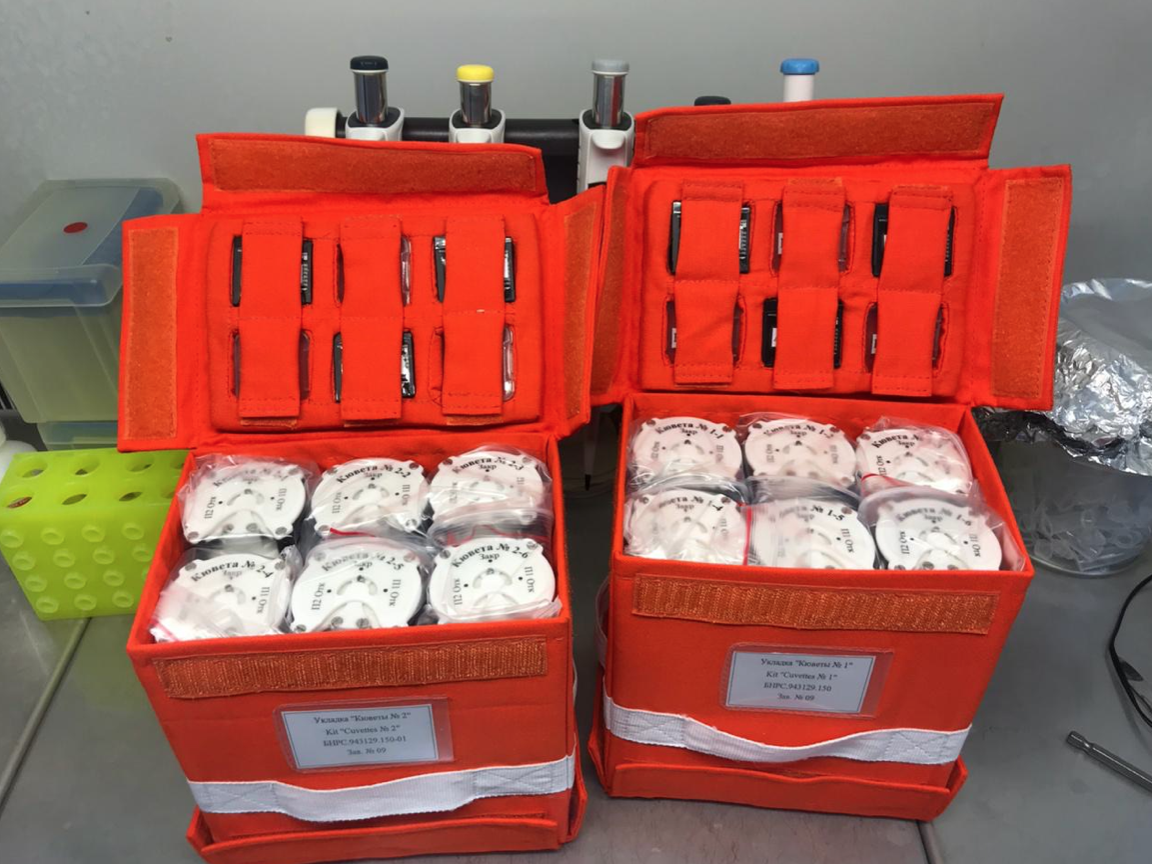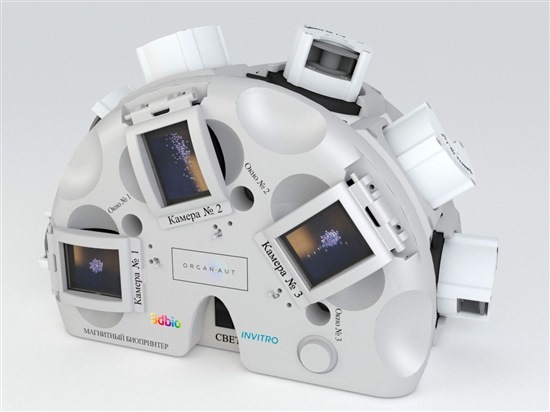Moscow-based bioprinting company 3D Bioprinting Solutions has engaged in a series of unique experiments in orbit thanks to a space bioprinter of their own design, the Organ.Aut. It was the world’s first space bioprinter launched to the International Space Station (ISS) in 2018, and since then, the device has been used to bioprint several tissues, including 3D bioprinting bone tissue in space for the first time using growing fragments of bone structures, as well as to carry out a high molecular weight protein crystallization experiment in zero gravity. Now, we have learned that Russian cosmonauts at the station are using the machine to produce bone tissue for mice and that those samples will, later on, be sent to Earth for a close examination, and eventually implanted into living mice as part of the experiment.
3D Bioprinting Solutions is moving strictly on schedule with their scientific work on Earth and in space without any delays, despite the lockdown that has a great part of the world population staying at home to avoid the spread of the COVID-19 virus. This means that the company is moving on with its projects. Along those lines, they also announced that their scientists had prepared a new batch of small containers, or cuvettes, which, in compliance with all necessary precautions, were safely delivered to the ISS in early April. Furthermore, on April 11, the space crew reported that the first session of the experiment had been completed and that new bone tissue constructs were printed.
The plan is to conduct a new scientific experiment on printing and recrystallization of bone tissue structures in microgravity conditions. The company claims that the uniqueness and fundamental difference from the previous Organ.Aut sessions are that the components of bone tissue printed in space will subsequently be used for transplantation to laboratory animals on Earth. Thus, scientists from 3D Bioprinting Solutions will be taking a fundamentally new step for space biomedicine, as they prepare the world’s first transplant of space material from recrystallized calcium phosphate granules to laboratory animals with bone defects.
“The whole story of Organ.Aut’s creation, its launch into space and work onboard the ISS in collaboration with the Russian State Space Corporation ROSCOSMOS, is a vivid example of resilience, an unbending will to win and the achievement of set goals despite all the obstacles that may arise. We are proud that even in the face of a difficult epidemiological situation and complete border closures, our team was able to timely prepare for new experiments and now looks forward to studying its results,” indicated Yusef Khesuani, co-founder and Managing Partner of 3D Bioprinting Solutions, when consulted by 3DPrint.com about the new endeavor.
While the previous Organ.Aut sessions served as a prove-of-principal to bioprinting organ constructs in space, this new and on-going experiment is designed to show the possibility of using unique materials made by the space bioprinter for transplantation in live animals and subsequently for treating human patients. In the future, the company expects that this new technology will allow the growth of bone implants for astronauts and be able to aid in carrying out transplantations directly during space flights, especially with the planned upcoming long-range interplanetary expeditions.
Moreover, the company claims that during manned flights to Mars (which are expected to land by 2025) or throughout potential human work at the future lunar base, cosmonauts will be isolated for a long time, and, in these circumstances, providing them with specialized medical care could become problematic. Thereby, they expect it will be necessary to create new means of space biomedicine to aid in the formation of body tissues in zero gravity so that they can transplant them to cosmonauts if they become ill or get injured.
Last year, Russian scientists from 3D Bioprinting Solutions had already managed to grow fragments of a bone structure in space under zero gravity. Tissue samples were made from calcium phosphate ceramics, which were populated with living cells, during experiments that took place on the spacecraft. These are currently being comprehensively studied on Earth.
This means that Russian scientists have come close to solving this problem for skeleton bones by conducting relevant experiments on the ISS. Currently, 3D Bioprinting Solutions experts have managed to solve the difficult task of processing material using biofabrication technologies, which involve the artificial creation of biological objects. Their first batch was launched to the ISS on August 22, 2019. During the following experiment, cosmonauts used the Organ.Aut bioprinter, which allows 3D assembly of tissue structures.
The specialized device, which was developed to carry out the world’s first experiment for printing living tissues, was delivered to the space station on December 3, 2018, aboard the manned Soyuz MS-11 spacecraft. It uses magnetic levitation technology in zero gravity conditions, thereby the object is not created in layers, as in conventional 3D printers, but immediately from all sides, something the companies described was done according to the principle of modeling snowballs. Using this method of production, Russian cosmonauts have managed to form a fragment of bone tissue with a spheroid shape from ceramic particles. After which the fragments began to interact with each other, forming stable chemical bonds. Then, live osteogenic cells were distributed evenly on the surface of the spheroid, which subsequently formed a tissue-engineered structure.
On October 2, 2019, the previously described samples successfully reached Earth on a descent vehicle, preserving their integrity and properties. Currently, they are studied in detail by scientists who confirm that the resulting material has high biological activity, which in the future would allow them to create bone tissue in minimum time. The new project is part of 3D Bioprinting Solutions plans to continue experiments to grow tissues in orbit. In particular, they plan to gradually make the shape of the bones grown more complex, bringing it closer to the biological characteristics of the original.
“Subsequently, we are going to complicate the geometry of the created products, for which we will add sound waves to the basic effect of the printer that will work together with magnetic waves,” described Khesuani last year. “This will allow us to create tubular and branching objects, which in their shape will correspond to human bones and blood vessels.”
As the Organ.Aut space odyssey continues, and the company moves on with their projects using biomaterials to fabricate tissue in zero gravity, the new technology will prove just how far space biomedicine can go, at least for now. The company’s ultimate and idyllic aim is to allow the growth of bone implants for transplantation operations of cosmonauts without the need for them to return to Earth. In this sense, the company is moving quickly, taking all of the necessary precautions to continue their work and looking for ways to solve some of the major problems that could arise in the long run, once humans finally travel to the Moon or other planets. It might seem far away, yet it’s never too early to start working on potential solutions to unforeseen circumstances. And space exploration could be the most challenging activity humans could ever undertake.
Subscribe to Our Email Newsletter
Stay up-to-date on all the latest news from the 3D printing industry and receive information and offers from third party vendors.
You May Also Like
Gorilla Sports GE’s First 3D Printed Titanium Cast
How do you help a gorilla with a broken arm? Sounds like the start of a bad joke a zookeeper might tell, but it’s an actual dilemma recently faced by...
Nylon 3D Printed Parts Made More Functional with Coatings & Colors
Parts 3D printed from polyamide (PA, Nylon) 12 using powder bed fusion (PBF) are a mainstay in the additive manufacturing (AM) industry. While post-finishing processes have improved the porosity of...
$25M to Back Sintavia’s Largest Expansion of Metal 3D Printing Capacity Since 2019
Sintavia, the digital manufacturing company specializing in mission-critical parts for strategic sectors, announced a $25 million investment to increase its production capacity, the largest expansion to its operations since 2019....
Velo3D Initiates Public Offering in a Bid to Strengthen Financial Foundations and Drive Future Growth
Velo3D (NYSE: VLD) has been among a number of publicly traded 3D printing firms that have attempted to weather the current macroeconomic climate. After posting a challenging financial report for 2023,...


































